Previous Biopsies on this Patient:
None
TPIS Related Resources:
Liver Transplant Topics
Neoplasia Transplant Topics
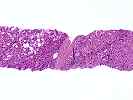
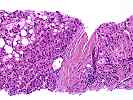
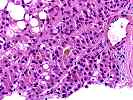
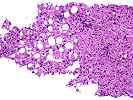
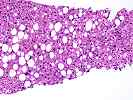

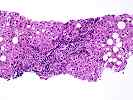
The tissue submitted consists of a needle biopsy of the liver with multiple portal triads. The architecture is distorted by focal portal to portal bridging fibrosis. The lobule shows mild to moderate macrovesicular steatosis, with occasional neutrophils. Convincing Mallory' s hyaline, sinusoidal fibrosis and perivenular sclerosis are not observed. There is no evidence for granulomatous inflammation, viral inclusions, duct loss or duct lesions. Also included in the sample are multiple foci of moderately differentiated neoplastic cells, which resemble hepatocytes, are arranged in trabeculae/pseudoglandular forms, and show bile production. The tumor is supplied by aberrant vessels, but no vascular invasion is seen.
The modified hepatitic activity index should be assigned as follows:
MODIFIED HEPATITIS ACTIVITY INDEX (HAI) GRADING
| GRADING | RANGE | SCORE |
|---|---|---|
| Periportal or periseptal interface hepatitis (piecemeal necrosis) | (0-4) | 1 |
| Confluent necrosis | (0-6) | 0 |
| Focal (spotty) lytic necrosis, apoptosis and focal inflammation | (0-4) | 2 |
| Portal inflammation. | (0-4) | 2 |
| TOTAL | (0-18) | 5/18 |
| STAGING Fibrosis |
(0-6) | 4-5/6 |
The presence of macrovesicular steatosis and scattered lobular neutrophils suggests that alcohol use, diabetes, and obesity be excluded as a cause of liver disease, even though all the criteria of a steatohepatitis are not satisfied. Viral and metabolic studies would also be of interest, if clinically indicated. The degree of fibrosis is difficult to estimate in peritumoral samples, but is felt to represent Stage 4 of 6 in Ishak et al' s scoring sytem. Clinical correlation with synthetic liver function tests and the degree of portal hypertension is suggested.